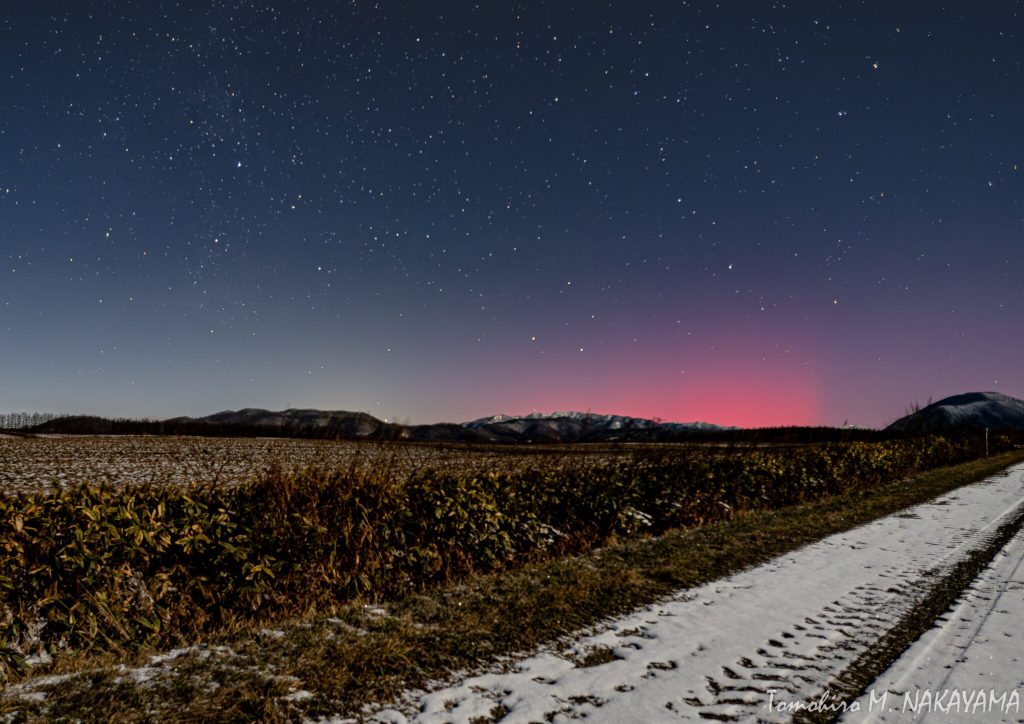Auroras float like a curtain in the sky at high-latitude places such as the North Pole and the South Pole. Last December, an aurora borealis was observed in Hokkaido, a lower-latitude region. Students of the Hokkaido University Astronomy Club managed to capture this “low-latitude aurora” in Shikaoi Town (central Hokkaido). The low-latitude aurora was characterized by a red glow in the sky, and it was the first time in about 20 years that it could be clearly observed with the naked eye. Auroras appear when the sun is active, and until the sun’s activity reaches a peak around the year 2025, there will still be more chances to observe them in Hokkaido. Shigeto Watanabe, Professor Emeritus at Hokkaido University, also explained how low-latitude auroras are visible.
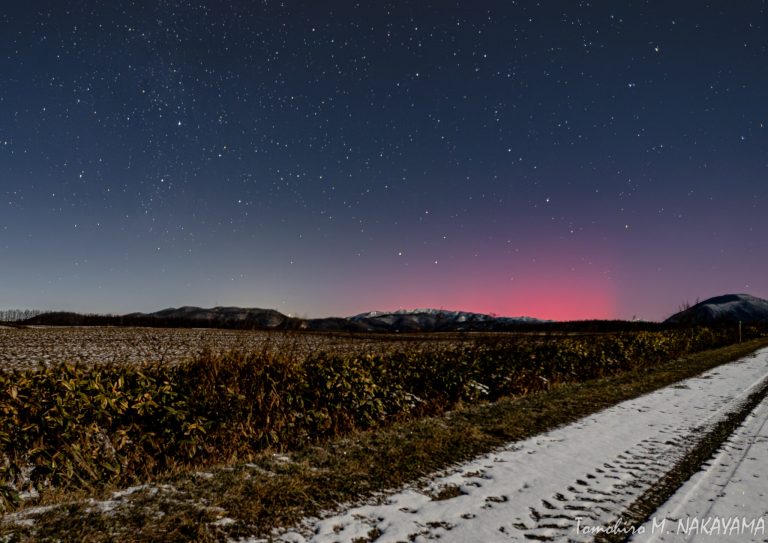
At around 6 PM on December 1, 2023, six members of the Hokkaido University Astronomy Club drove to Shikaoi Town, 180 kilometers east of Sapporo. They arrived at the observation site, where the temperature was 7 degrees below zero, at around 10 PM. The sky was of a dull reddish-purple color that looked like a sunset with a slightly different hue. Through the camera’s viewfinder, they witnessed several vertical lines that looked like pillars. This was evidence of the red aurora borealis, dancing without a sound.
Tomohiro Nakayama (B4, School of Agriculture) looked back on the day of the event and said, “Everyone was excited and enthusiastically captured the aurora with their cameras.”
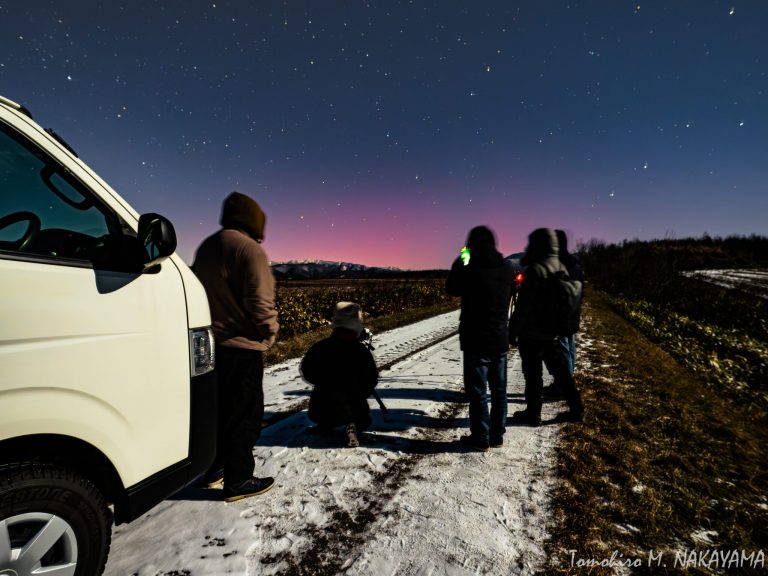
When he was a high school student in Okinawa Prefecture, he learned that the Northern Lights could be seen in Hokkaido, so he decided to enter Hokkaido University to witness the aurora in Japan. He joined the Astronomy Club and has previously attempted to observe the aurora borealis eight times, with no positive results. In the past, low-latitude auroras had been observed in the eastern and northern Hokkaido, including in Rikubetsu Town and Horokanai Town. For his ninth aurora observation attempt, Nakayama conducted his own investigation to predict the location where an aurora borealis could be observed.
According to Nakayama, the best place to observe the aurora is in the northern area where there is an unobstructed view of the northern sky, and no city lights to the north. He had his sights set on Shakotan Peninsula and Nayoro City, both of which are dark on the north side, but after preliminary inspections, he decided on Shikaoi Town because it met all of the conditions.
In addition, since the appearance of the aurora borealis is related to increased solar activity, Nakayama regularly checked National Oceanic and Atmospheric Administration (NOAA)’s website and other publicly available information for the solar activity logs. Nakayama recalled, “Until the very last minute I was still worried about whether to follow my prediction; even if I did go, I wasn’t sure if I would actually be able to witness the aurora. It felt like a gamble.”
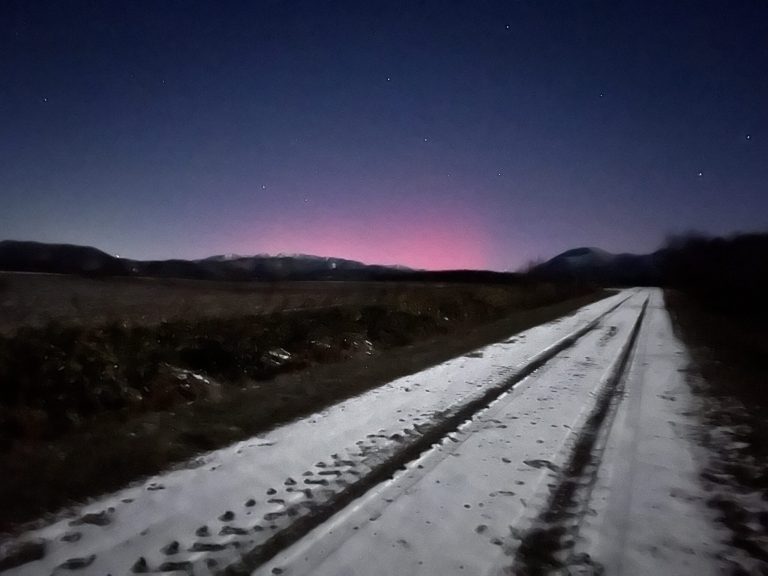
The low-latitude aurora observed in Shikaoi shone so brightly that the members of the club were able to capture it with their smartphones. Nakayama commented, “I think it was truly a miracle that we were able to see it this time thanks to the combination of good weather and various other favorable conditions. I was just so impressed. I would like to try photographing the northern lights again.”
Professor Emeritus Shigeto Watanabe, an expert in space science, confirmed that the photographs taken by the Astronomy Club show many vertical lines and pillars, which are evidence of an aurora shining along the Earth’s magnetic field lines. Watanabe explained how auroras are visible. “Auroras are a phenomenon in which nitrogen and oxygen in the Earth’s air collide with high-energy particles called solar wind (plasma) from the sun.” Auroras can be seen at altitudes higher than 100 km above the North and South Poles. When oxygen atoms collide with high-energy plasma, green glow occurs, and when they collide with low-energy plasma, red glow occurs. Red auroras are seen at higher altitudes than green auroras. The more active the sun is, the larger the aurora extends vertically. In other words, auroras visible from low latitudes such as Hokkaido are the upper red portion of a large aurora that occurs near the North Pole.
Watanabe said, “My grandparents used to live in Urakawa Town (Hokkaido). In the 1950s they were surprised when the northern sky suddenly turned red. The fire brigade went into the mountain stream thinking it was a forest fire, but in the end there was nothing there. My grandparents must have seen the low-latitude aurora as, according to the sources, aurora observations were active around the world at that time. In the past, the Ainu people may have seen the northern lights as well,” he recalled.

Auroras are generated by the solar wind, but because the Earth’s circumference is protected by magnetic field lines, the amount of plasma that falls directly from the sun to the Earth is understood to be very little. On the other hand, a “plasma sheet” is formed on the far side of the Earth from the sun, from which high-energy plasma flows along the magnetic field lines to the north and south poles and shines as brightly as the aurora does, but exactly how this occurs is still a mystery.
When an aurora is visible, it means that there is also a big shift in the magnetic field lines around the Earth, which can result in a major change in the temperature and density of the atmosphere, affecting the orbits of satellites. Watanabe explains, “Behind the beautiful aurora, there may be a major impact on communications with space, such as weather satellites and GPS, which is actually related to our daily lives. Aurora researchers are now studying space weather, including solar wind observations.”
It is likely that there will be more opportunities to observe low-latitude auroras in Hokkaido during the next few years as solar activity increases. Many photos taken by researchers and amateur astronomers may be available on the web. Let’s wait for more photos to be taken by researchers and amateur astronomers.
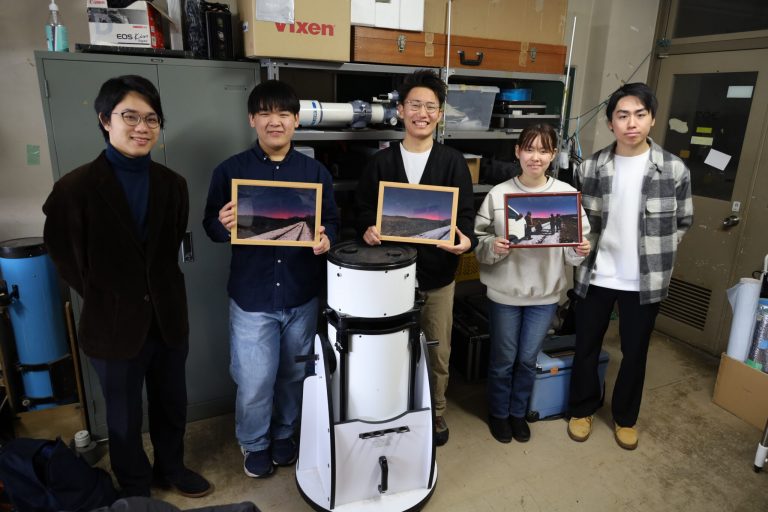
Originally written in Japanese by Yuka Saito
Illustration by Miho Nagao
Rearranged by Aprilia Agatha Gunawan


